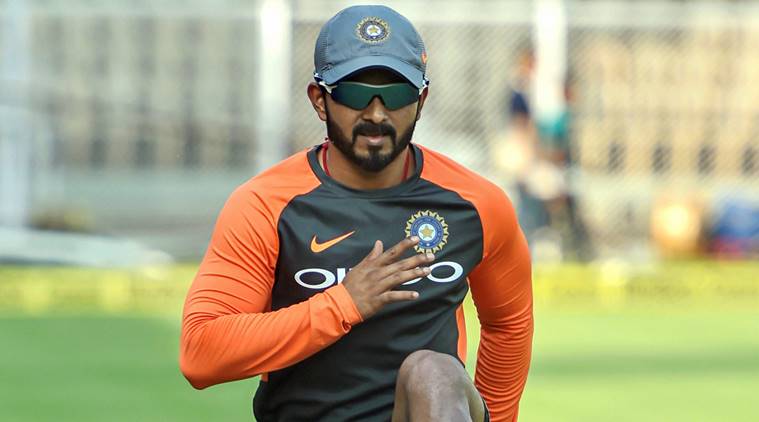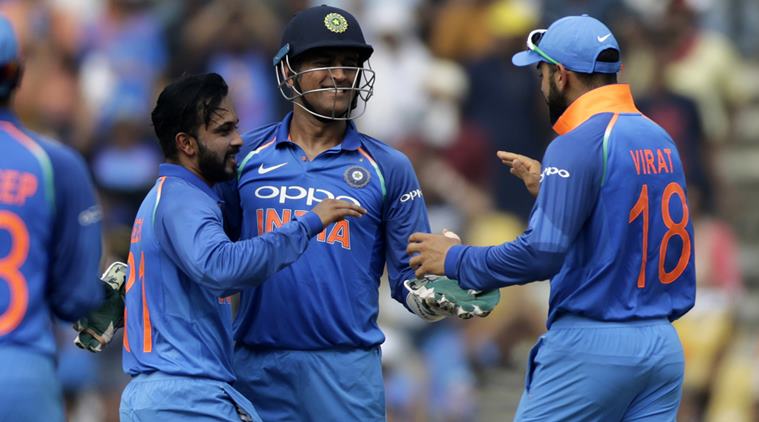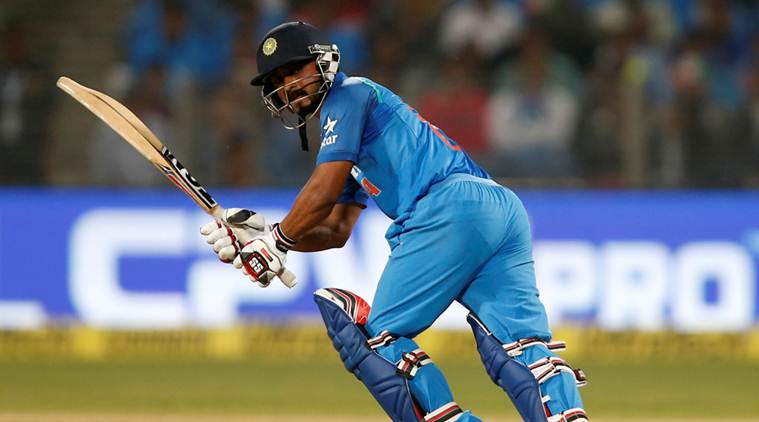Having learnt his trade on the unforgiving Pune tennis-ball cricket circuit, Kedar Jadhav brings his unique version of street-smartness to the Indian team which aims to become more than the sum of its parts.
Thank you for reading this post, don't forget to subscribe!
Shared News| Updated: May 25, 2019 9:42:20 am
Every team has a player who embodies its key characteristics and central philosophy. For India, that man is Jadhav. (Illustration: Suvajit De)
Broad blades came later, thick skin was needed first here.
Just two minutes ago, Akon was pledging ridiculously crass affection to the batsman with his gaudy albeit groovy ‘I wanna love you’ as the announcer declared him the emperor of all realms in embellished Marathi. Next instance, the batsman was sheared off his swag after playing a howler of a shot.
The loud speaker now blared out after the batsman all the way back: “chhachhundar ke sar pe na bhaaye chameli, kaha raja Bhoj, kaha Gangu Teli.” The taunting voice, fancying himself as a commentator, next picked on the bowler marking his run-up.
Running commentary — audible to players — literally shreds them as it rambles on to include tirades over the general uselessness of the dismissed batsman or a bowler whipped for runs. Failure is amplified for consumption.
Since the late 1990s — when a teenaged boy, who loved to bat and bowl pace despite his little frame, found himself in this crucible of catcalls on a cricket pitch — to 2019, not much has changed.
There is no way Kedar Jadhav was going to forget Mulshi — Pune’s wild, wild, west. Or the tennis-ball cricket tournaments here and in the city’s far-flung grounds at Yerawada and Warje, which shaped his early game and forged a mind that would not crumble in the face of pressure.

Kedar Jadhav’s participation in the upcoming World Cup was doubtful after he injured his shoulder during IPL. (PTI/File Photo)
Sledging him might be the dumbest ploy to unsettle this batsman — he has grown up on the staple of the legendary Puneri rudeness for 34 years, and tennis-ball trolling was part of his cricket education.
A little more about charming Mulshi: nestled amongst rolling hills along the Pune-Mumbai highway (about 13 km from Pune’s Gahunje stadium), this scenic area teems with the severely reviled ‘Gunthe Patils’ — previously farm owners who sold off their land to let IT parks rise on the skyline. They came into sudden money and spent it on gold chains, Scorpios and crisp whites. And then blew it all up in some years, lurching into a life of village bullies and enforcers.
A cricket match at Mulshi is a perfect place for them to troop in and make their presence felt. Small-time politicians would announce 10-over tennis-ball championships, and the unregulated tournaments would see players trooping in from the city, subjected to palpable pressure to win matches. Or else … get taunted all the way back home.

With a hectoring voice behind the mic, ensuring you hear the last snide detail of what spectators are thinking about you, a lot would be tangibly at stake with these wild characters treating cricket like a do-or-die prizefight. Even their egging-on was full of menace.
Jadhav played his early cricket amidst this cacophony raining down on his every run.
There were crazy pitches of course. But mostly, tennis-ball cricket was about unconventional bowlers with non-repeatable actions. They’d bowl strange square-arm but never settle onto one awkward action either. Dealing with that labyrinth of interlopers, constantly finding solutions to cricket’s whackiest bowlers, Jadhav learnt tricks that a leather-ball summer camp would’ve never taught him.
Jadhav grew up in middle-class Kothrud, almost a halfway-point between Pune’s former international venue — Nehru Stadium – and onwards to the swanky new hole-in-the-rock wall Gahunje. The last few Pune cricketers to make it to the Indian team were earnest products of the formalised system that grew within the inner city. Hrishikesh Kanitkar, of course, came with pedigree, while Dheeraj Jadhav, the elegant southpaw boasted a correct and gentle technique.
Kedar went to nearby MIT school, by no means a cricket nursery, and when he drifted towards tennis-ball cricket, it was a constant struggle to compensate for strength since he was always playing with older boys. This meant he compulsively sought developing of new strokes, acuter angles and bowling a variety which shows up in his hugely unorthodox off-spin.

Kedar Jadhav often crouches a bit and his round-arm, Lasith Malinga style delivery further exaggerates his low release (Source: AP)
Jadhav is remarkably self-effacing about his off-spin. He once said: “Jisko koi bowling nahi aati, woh off-spin daalta hai,” trying to explain why he’s constantly searching for creativity to cut through the clutter. Appearing on a web series ‘What the Duck’ with Harbhajan Singh, he also elaborated on how he got bored, realising even a No.10 can attack his off-spin, and developed the delivery which takes forever to reach the stumps.
He gleefully enjoyed watching Tamim Iqbal complete a slog sweep, while the ball dawdled in the air teasingly and threatened to never reach the flummoxed batsmen. Closest in age to MS Dhoni in the Indian team, the duo seem to revel in plotting batsmen’s downfall. Harbhajan has even offered a bounty of Rs 100 to anyone who can hit a backfoot six off Jadhav.
Aware since his tennis-ball days that just his batting would never be enough, Jadhav went about honing his bowling and ‘keeping as well.

Kedar Jadhav. (Source: Reuters)
But it’s his batting that throws up some remarkable tales from the myriad maidans. A former team-mate talks of the time when Jadhav would announce he was going to target a specific bowler, and cart him for three sixes. To another upstart — a strapping tyro whose mind he wanted to mess with — Jadhav not only stepped out of the crease after some words were exchanged. He sat down on one knee at good length and swept every ball of the over thereafter.
“Then he challenged the bowler,” the team-mate recalls. “He said, ‘forget right-handed, I’ll bat left-handed against you.’” The man loves his skirmishes.
Former opener and state captain Surendra Bhave, who watched Jadhav rise through the u-19 ranks, remembers an extremely nonchalant batsman with free-flowing strokes in the Cooch Behar Trophy once he had settled into leather-ball cricket.
Bhave was part of the Maharashtra support staff in 2013 and remembers training himself to stay calm and breathe deep, just watching Jadhav go about his innings. “First 10-15 balls, you can’t imagine what he’d do. They’d be very tense moments for us. His choice of shots defied all reason but he knew exactly what he was doing. He liked getting into an ‘either Me or You’ battle with bowlers. I’m a very different batsman – it was scary,” says the copybook opener, a world apart from the street-smart, adventurous Jadhav. “The best thing I’ve done in my career as a coach is to not change Kedar Jadhav’s method. In fact, there is no point trying to be methodical with him,” he laughs.
Calling him an outstanding assessor of situations, Bhave says Jadhav’s go-to move is always attack, and he backs himself to play that blistering game and invert the pressure on bowlers. “Especially, he’ll take a real toll on spinners on treacherous slow turners – sweeping low from the stump line and cutting inside out.”
Unsparing on any bowler, Jadhav liked to assert his dominance over them with his signature square cut, and club team-mates recall him playing the inside-out shot over extra-cover since 1998-99, a decade before he was sort of a revelation for Maharashtra.
He’d always been street-smart and had an uncanny ability to find a fielding position from where he anticipated shots and effected run-outs. But more than anything else, it was his combative and unflinching nature as he took on mightier opponents and worked out ways to best them, which will remain the legacy of his tennis-ball origins.
Once his father (who left arid Solapur for Pune to escape a water crisis) had put his foot down nudging Kedar towards the leather ball (and ending even mention of the tennis ball), Maharashta Cricket Association’s Ajay Shirke took over. Shirke himself went to a school which swore by football and basketball and never quite boasted a cricket culture. But he was determined to keep Jadhav, a distinct outsider in terms of his unorthodox play, firmly inside. He’d routinely chastise Jadhav about how disappointed he’d be if he wasted his talent. Praise was especially held back, so Jadhav was pushed to add to his already burgeoning bag of tricks in order to stake a claim to the India cap.
***
Bhave also recalls a clarity of ambition very rare in cricketers from Maharashtra (as opposed to Mumbai, their illustrious West Zone rivals). “It was basically his attitude. He didn’t want to finish a 10-year domestic career with an average of 35. He wanted one or two big seasons and didn’t want to be boring by any stretch of imagination,” he says. Not staying boring was important to the constant fiddler and tweaker.
While he would go through the traditional pathways eventually — in Pune, it’s PYC, Deccan Gymkhana, Poona Club for example — Jadhav would stay loyal to his early clubs and remain thick with friends he’d grown up with. Inside dressing rooms, his mimicry, dancing and the ability to be cheeky as well as take a joke on himself, had stayed consistent. A couple of 150s in the U-19s and later a 300 vs Uttar Pradesh had got people to notice him, but it was in the Ranji semis knock against Mumbai that Jadhav convinced the hard-to-please veterans of Maharashtra that he had what it takes.
On a seaming (and progressively slowing) track with Zaheer Khan and Shardul Thakur darting the ball both ways, Jadhav soaked up the pressure after Maharashtra had conceded a 121-run first-innings lead and then bowled Mumbai out for 130.
To start with, he left everything outside off on the fourth morning. ‘Pitch No. 3’ at Wankhede holds some old demons for generations of Maharashtra batsmen. But Jadhav would stand outside the crease and step out to fast bowlers showing some serious intent and a casual disregard for haunting nightmares.
He even left balls that were wandering way outside the off-stump, and compelled bowlers to aim at the stumps. Then with 60 runs left, he picked on left-arm spinner Vishal Dabholkar, and his three sixes finished the match in a jiffy. Yet another time, on a pitch where 20 wickets fell on Day 1 and the match ended on Day 2, Jadhav’s 57 had been the difference between the two teams.
So, grafting ain’t a problem here – for the man who, when he gets a look-in, will be expected to be the ‘finisher’ at the World Cup. “My only advice to Kedar is be prepared for a 20/2 situation,” Bhave says as the team sets off for the World Cup. Injuries, he has shrugged off before.
“Just be careful when you have more than 40 balls to play. His game in ODIs is tailored for those 40 deliveries – the crunch. But be prepared for the long haul if you get into that 20-2 scenario.”
With the 2019 squad short of star power compared to the 2011 galacticos, especially in the middle order, Jadhav’s street-smartness in dealing with various situations will be crucial for a team that aims to be more than the sum of its parts.
While tennis-ball cricket might’ve given him the smarts to deal with every situation, Jadhav has not stopped learning. Whether it’s starting on meat — chicken, fish and lamb, or getting onto captain Kohli’s fitness drills, or simply video-analysis. “He’s started watching his own videos since 2010 and is constantly thinking about how to middle the ball. He’s not very big on net batting, but loves knock-downs. It’s where he tweaks the smaller things — hip position, body shape and getting into a good head space.”
For everything else, there’s memories of Mulshi and its menacing cauldron.




